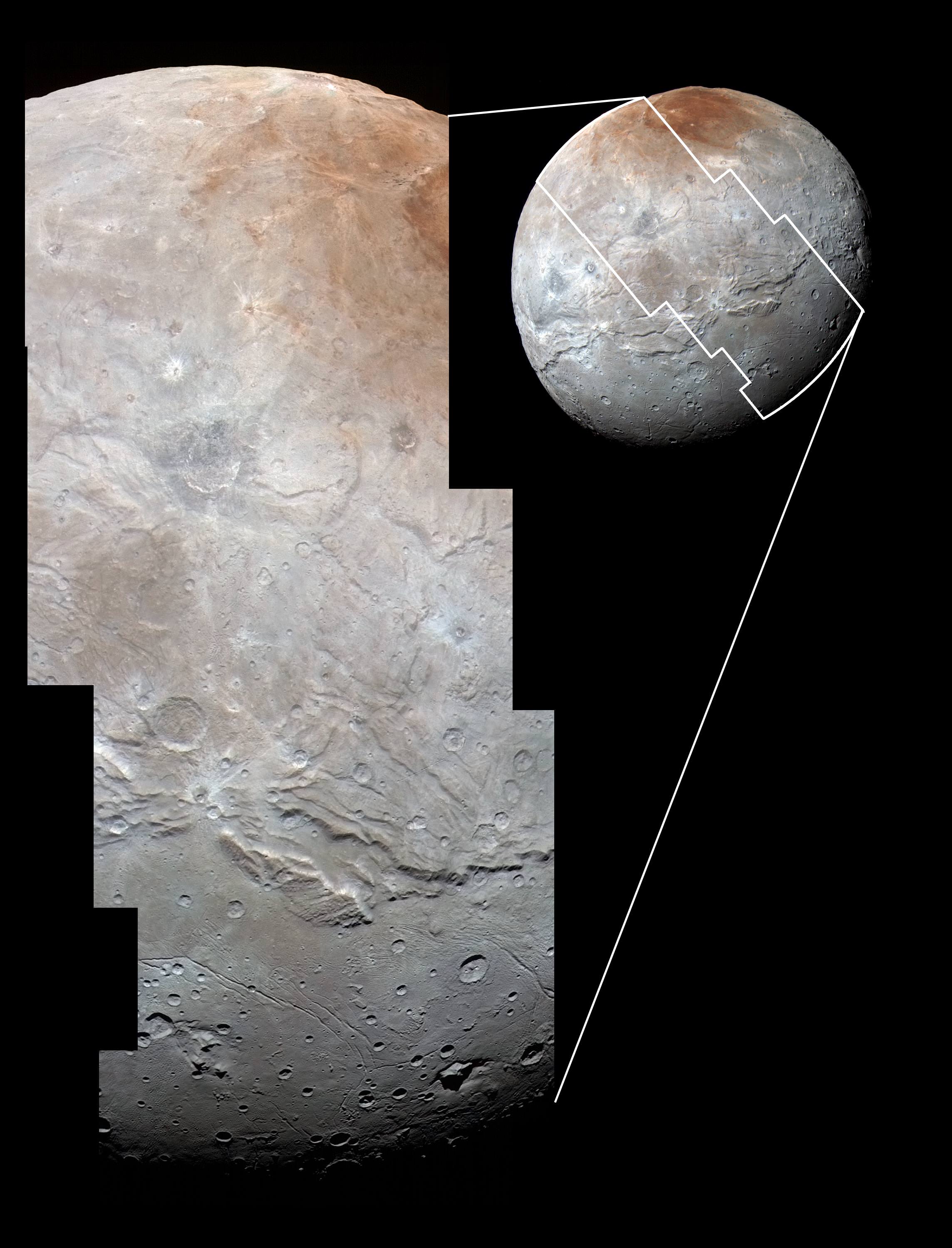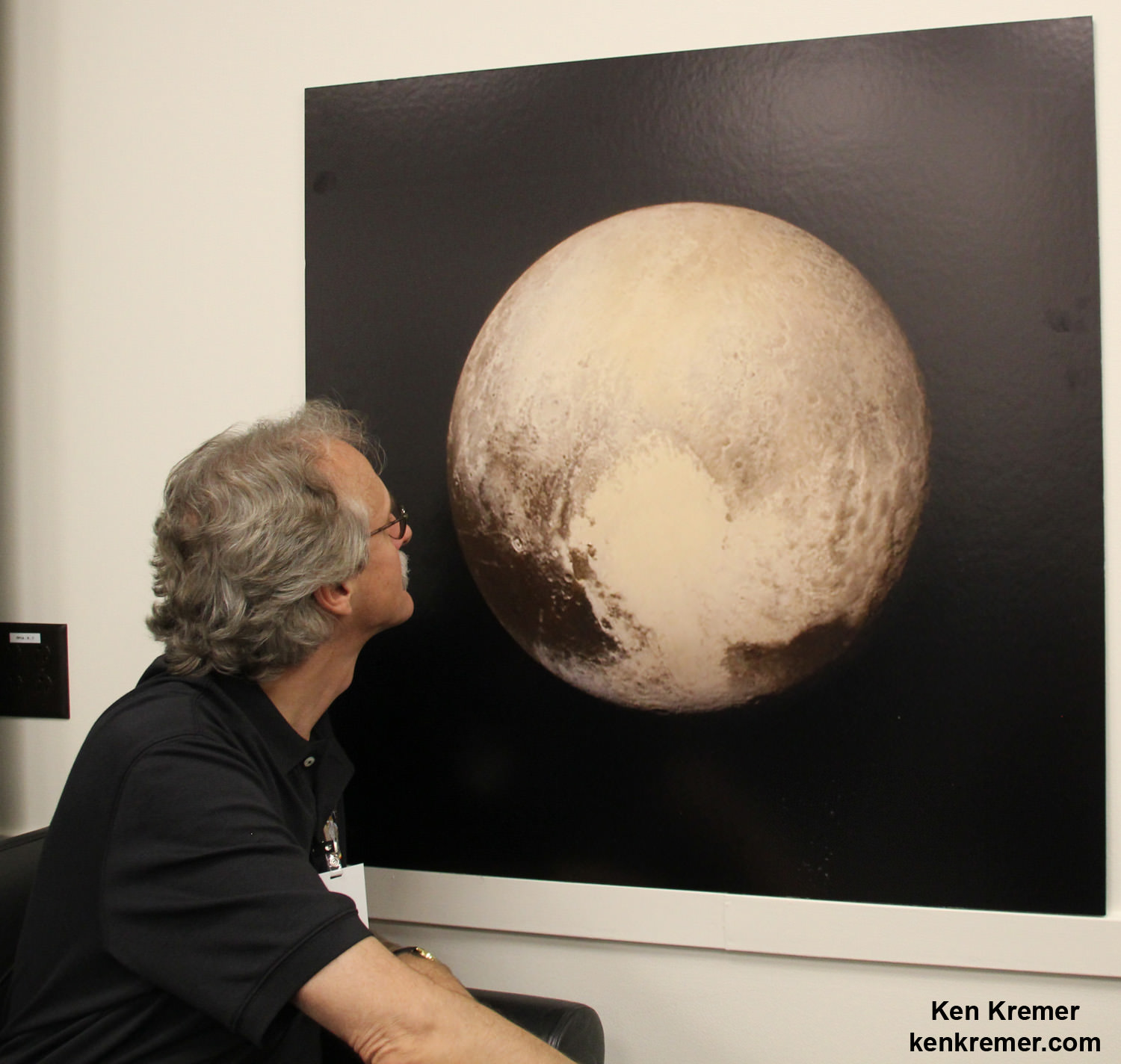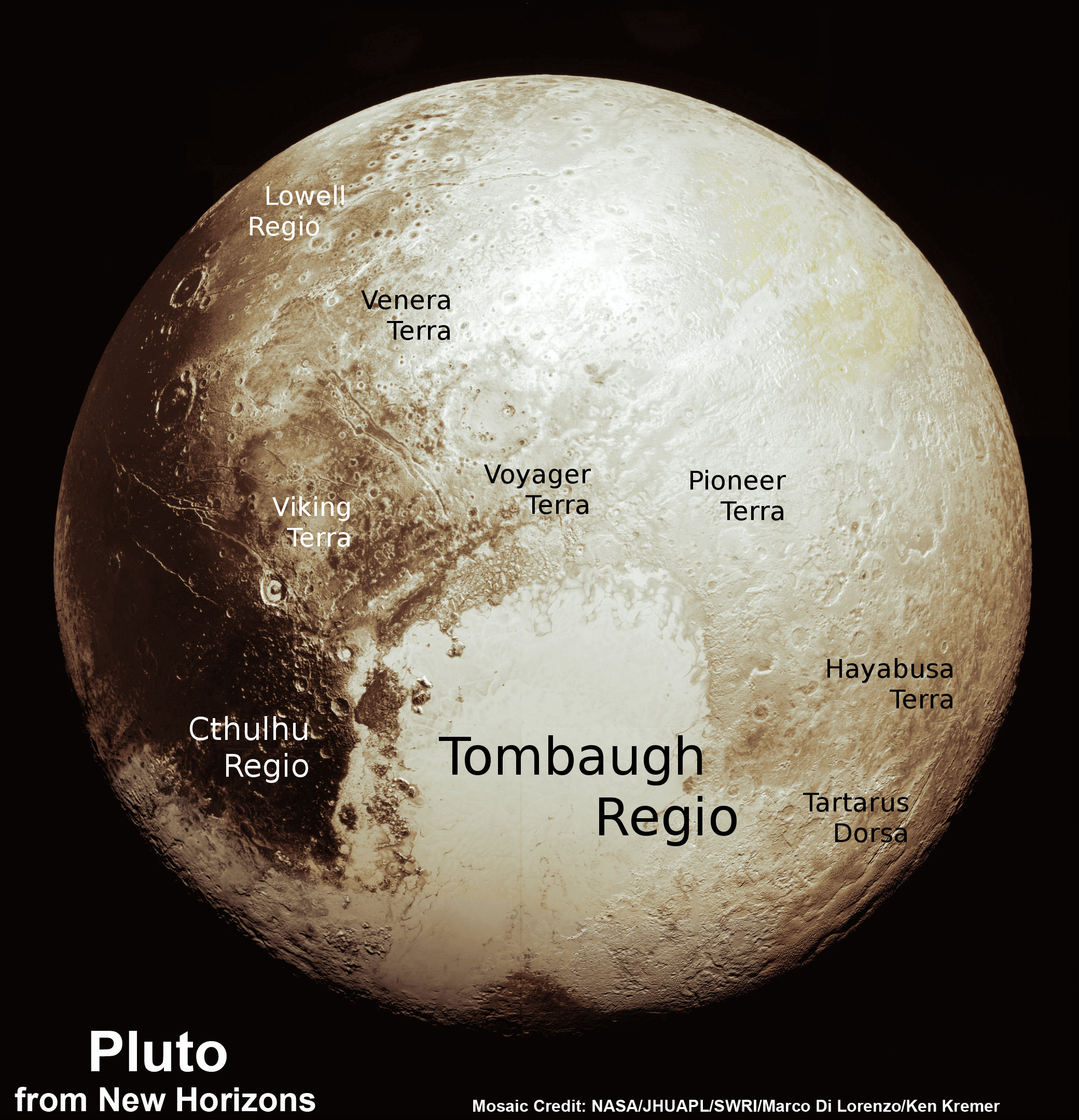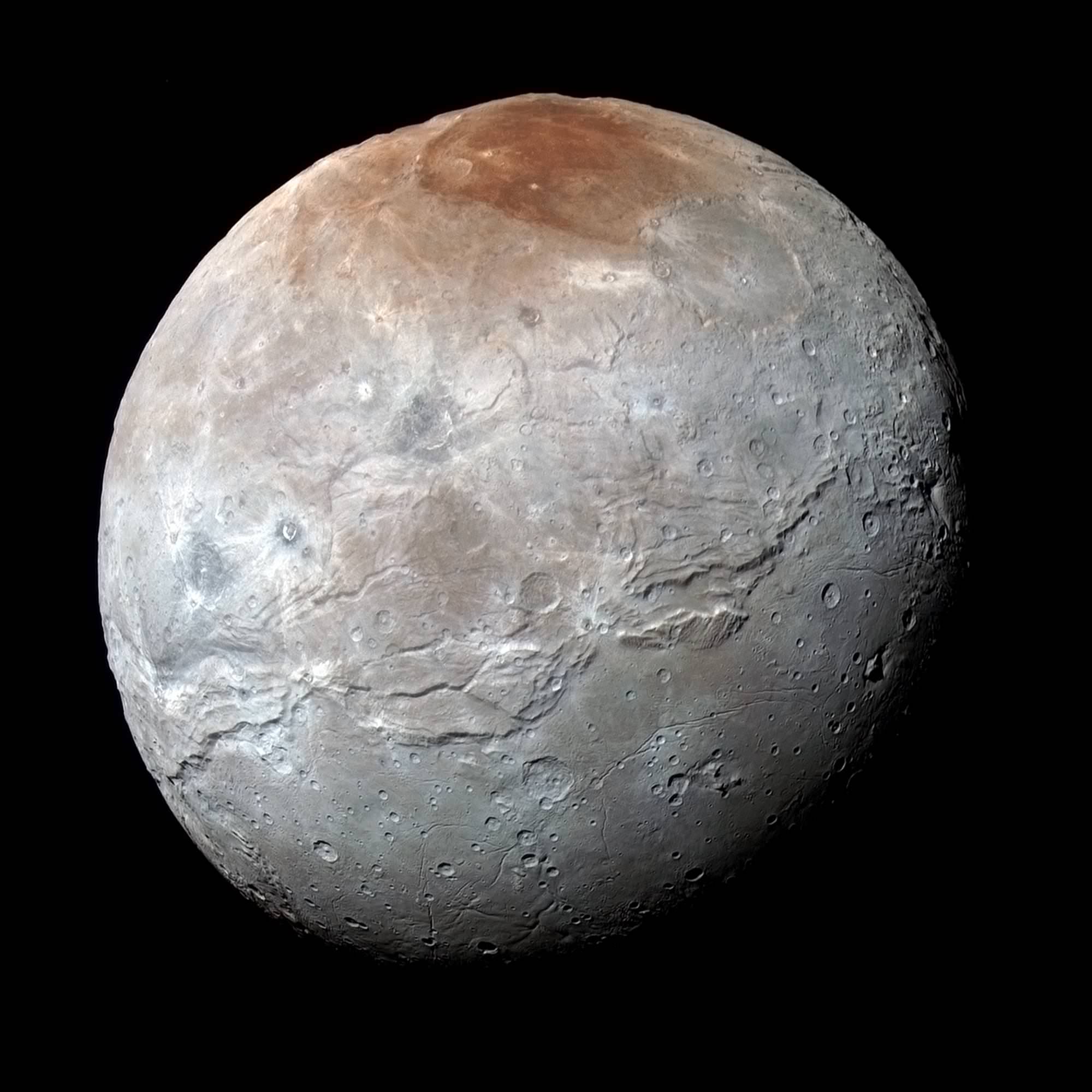Charon in Enhanced Color with Grand Canyon
NASA’s New Horizons captured this high-resolution enhanced color view of Charon and its Grand Canyon just before closest approach on July 14, 2015. The image combines blue, red and infrared images taken by the spacecraft’s Ralph/Multispectral Visual Imaging Camera (MVIC); the colors are processed to best highlight the variation of surface properties across Charon. Charon’s color palette is not as diverse as Pluto’s; most striking is the reddish north (top) polar region, informally named Mordor Macula. Charon is 754 miles (1,214 kilometers) across; this image resolves details as small as 1.8 miles (2.9 kilometers). Credits: NASA/JHUAPL/SwRI[/caption]
Charon suffered such a surprisingly violent past of titanic upheavals that they created a humongous canyon stretching across the entire face of Pluto’s largest moon – as revealed in a fresh batch of images just returned from NASA’s New Horizons spacecraft.
We have been agog in amazement these past few weeks as New Horizons focused its attention on transmitting astounding high resolution imagery and data of Pluto, captured during mankind’s history making first encounter with our solar systems last unexplored planet on July 14, 2015, at a distance of 7,750 miles (12,500 kilometers).
Now after tantalizing hints we see that Charon, Pluto’s largest moon, did
not disappoint and is no less exciting than the “snakeskin texture mountains” of Pluto revealed only last week.
“You’ll love this,” said New Horizons Principal Investigator Alan Stern of the Southwest Research Institute, Boulder, Colorado, in a blog posting.
Indeed researches say Charon’s tortured landscape of otherworldly canyons, mountains and more far exceeds scientists preconceived notions of a “monotonous, crater-battered world; instead, they’re finding a landscape covered with mountains, canyons, landslides, surface-color variations and more.”
“We thought the probability of seeing such interesting features on this satellite of a world at the far edge of our solar system was low,” said Ross Beyer, an affiliate of the New Horizons Geology, Geophysics and Imaging (GGI) team from the SETI Institute and NASA Ames Research Center in Mountain View, California, in a statement.
“But I couldn’t be more delighted with what we see.”
Measuring 754 miles (1,214 kilometers) across, Charon is half the diameter of Pluto and forms a double planet system. Charon also ranks as the largest satellite relative to its planet in the solar system. By comparison, Earth’s moon is one quarter the size of our home planet.
The new images of the Pluto-facing hemisphere of Charon were taken by New Horizons’ Long Range Reconnaissance Imager (LORRI) and the Ralph/Multispectral Visual Imaging Camera (MVIC) during the July 14 flyby and downlinked over about the past week and a half.
They reveal details of a belt of fractures and canyons just north of the moon’s equator.

The “Grand Canyon of Charon” stretches more than 1,000 miles (1,600 kilometers) across the entire face of Charon visible in the new images. Furthermore the deep canyon probably extends onto the far side of Pluto and hearkens back to Valles Marineris on Mars.
“It looks like the entire crust of Charon has been split open,” said John Spencer, deputy lead for GGI at the Southwest Research Institute in Boulder, Colorado, in a statement.
“With respect to its size relative to Charon, this feature is much like the vast Valles Marineris canyon system on Mars.”
Charon’s “Grand Canyon” is four times as long as the Grand Canyon of the United States. Plus its twice as deep in places. “These faults and canyons indicate a titanic geological upheaval in Charon’s past,” according to the New Horizons team.

Another intriguing finding is the area south of the canyon is much smoother, with fewer craters and may have been resurfaced by a type of “cryovolcanism.”
The southern plains are informally named “Vulcan Planum” and may be much younger.
“The team is discussing the possibility that an internal water ocean could have frozen long ago, and the resulting volume change could have led to Charon cracking open, allowing water-based lavas to reach the surface at that time,” said Paul Schenk, a New Horizons team member from the Lunar and Planetary Institute in Houston.
The piano shaped probe gathered about 50 gigabits of data as it hurtled past Pluto, its largest moon Charon and four smaller moons.
Barely 5 or 6 percent of the 50 gigabits of data captured by New Horizons has been received by ground stations back on Earth due to the slow downlink rate.
Stern says it will take about a year for all the data to get back. Many astounding discoveries await.
“I predict Charon’s story will become even more amazing!” said mission Project Scientist Hal Weaver, of the Johns Hopkins University Applied Physics Laboratory in Laurel, Maryland.

Stay tuned here for Ken’s continuing Earth and planetary science and human spaceflight news.



I thought the distance of closest approach was more like 14k miles, not 50k? Or is that the distance of closest approach to Charon which was at the far side of the orbit….
I certainly agree the whole southern region has marking of cyrovolcanism – not just Moat Mountain but several other features on a similar scale and smaller of dips and sink-hole type areas but on a huge scale relative to the normal things we think of.
typo fixed
And it looks like Charon had some more “recent” significant impacts left of the redish pole area and up over the limb. The rest of the surface’s impacts appear to be smooth to the surface. That’s a difference in addition to the canyon system and southern melt affects.
And some weird hatch canyon shaping – middle dark gray area, upper canyon system coming in from the left and the major finger ends in a nice round crater. Right after that to the right there a couple linear canyon-like features. Another set but different north of Moat Mount. Slightly reminds me of the linear features on Europa except only “tiny” segments….
The surface seems to have all kinds of unique features in one area and not others! Very amazing!
Seeing is not always believing but it appears that the “reddish’ polar area on Charon and the ‘reddish’ Cthulu region of Pluto are remarkable similar in color.